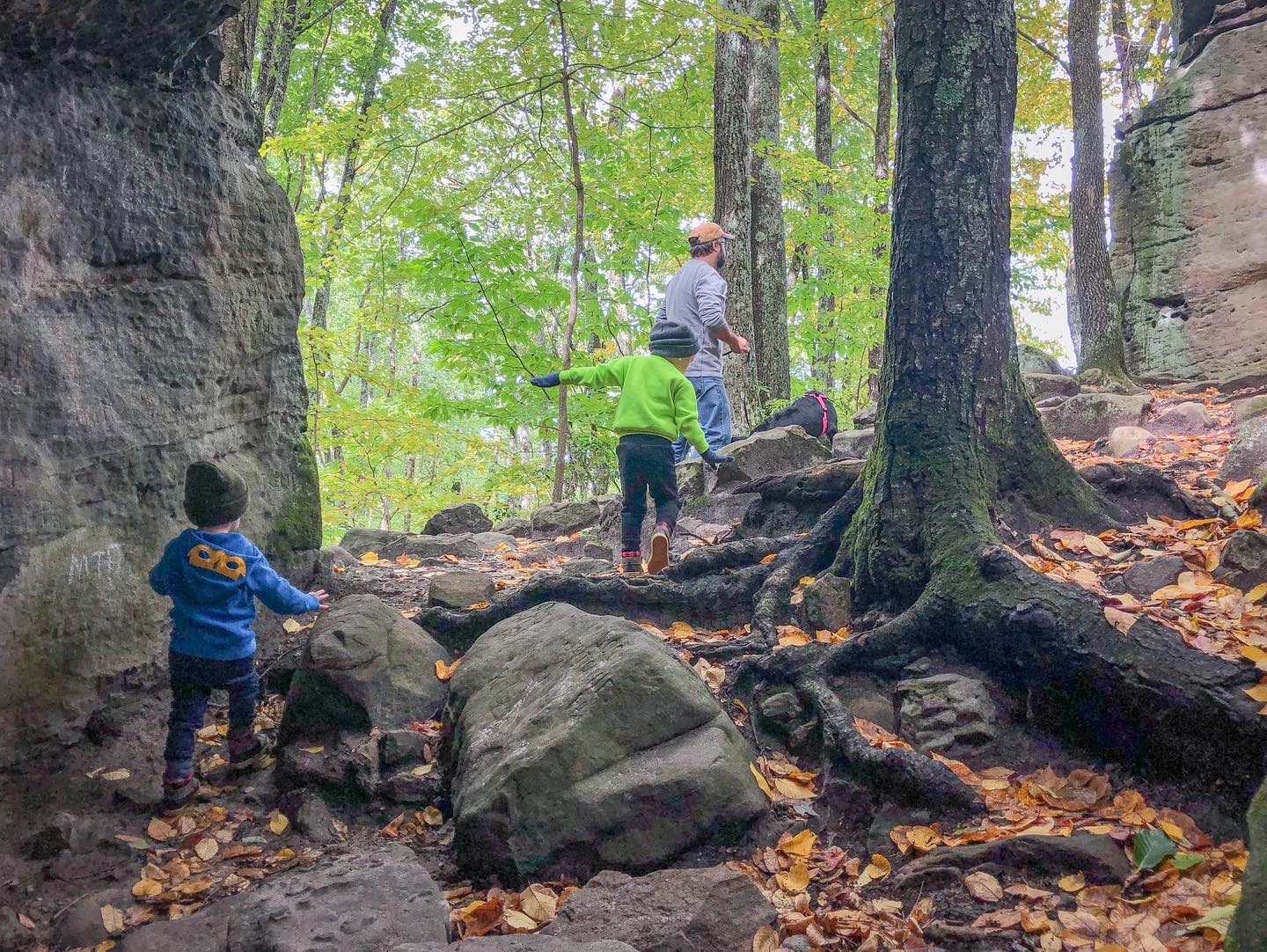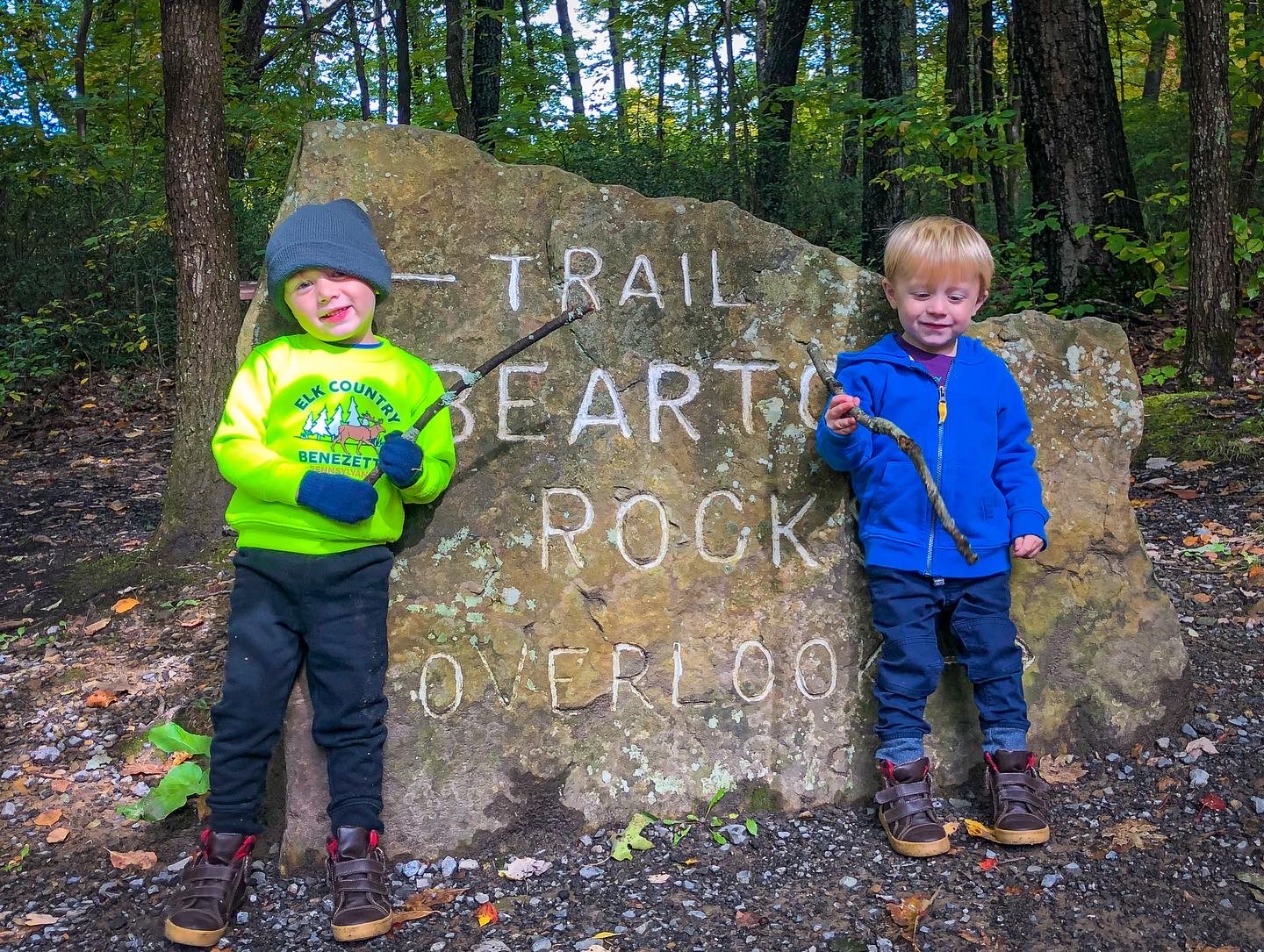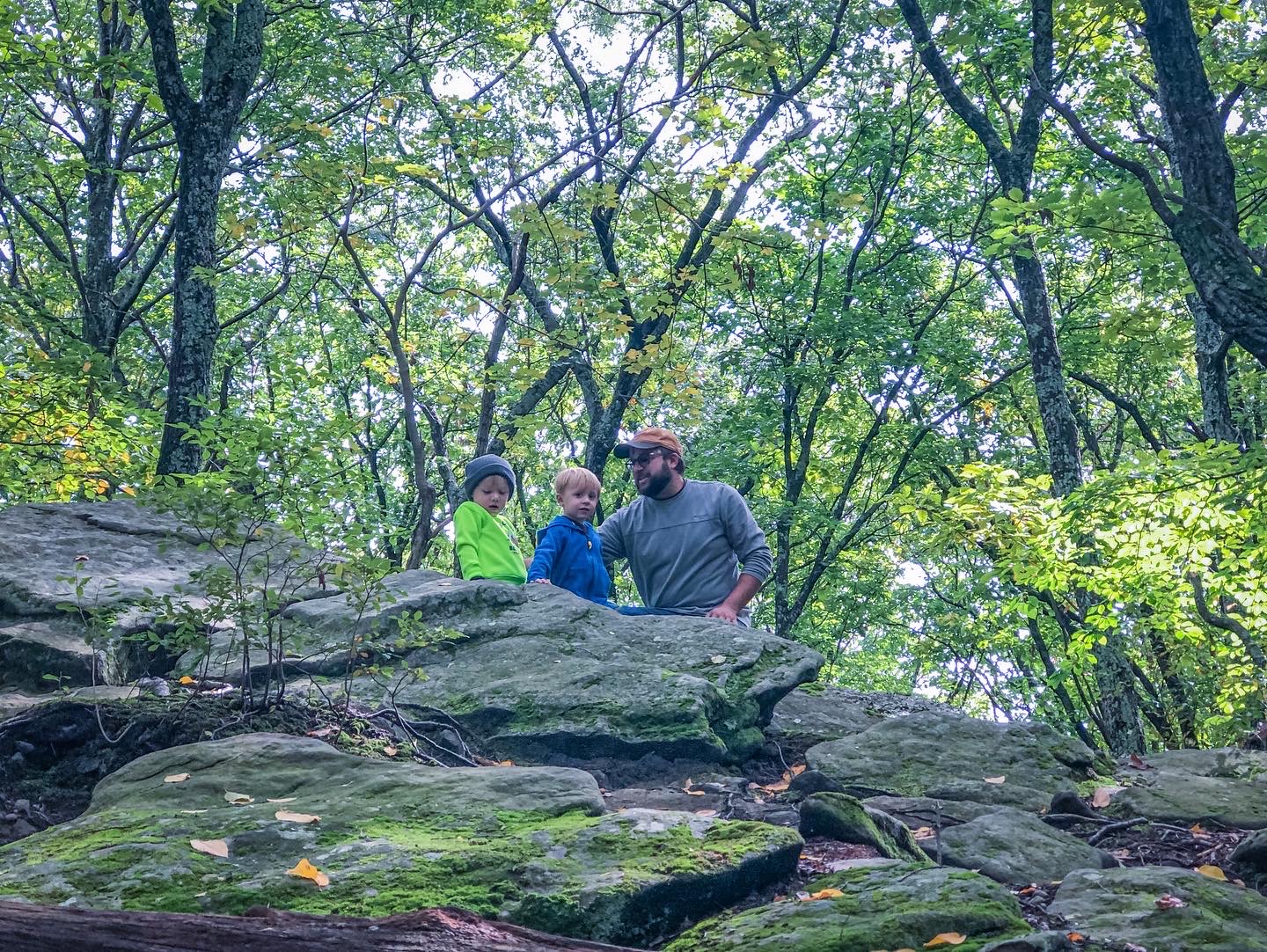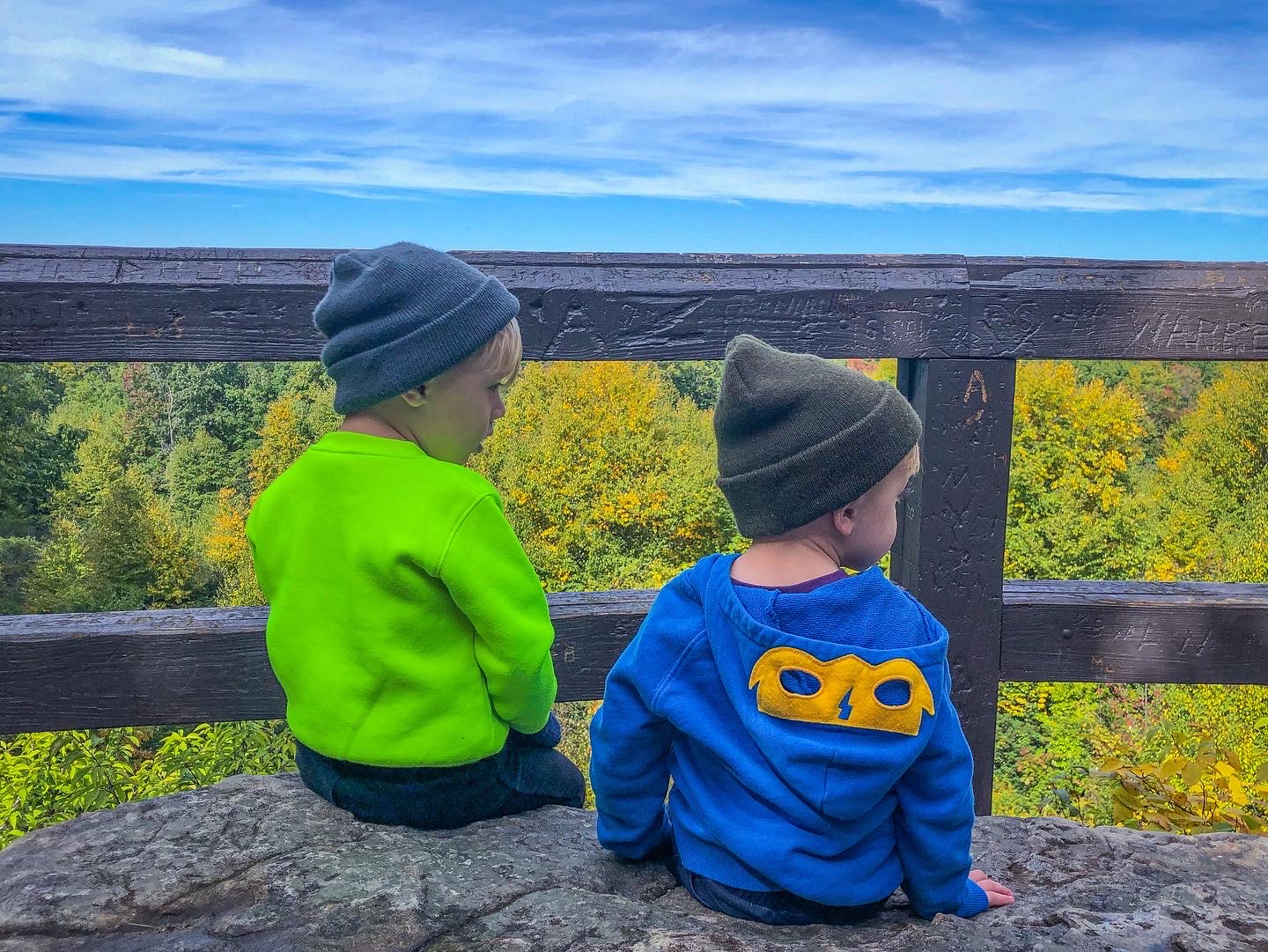Wilds Child: Climbing Beartown Rocks
I don’t think of myself as a particularly cautious mother, but there is something about seeing your preschool-aged son standing on the edge of a large boulder, soft, slippery moss underfoot, sun-bleached wooden railing to the side, and only fallen trees and rock outcroppings 20 feet below to catch their fall that makes your breath catch in your throat.
So, why did I bring my children to such a risky place? Hear me out.
Older folk like to complain about “children these days” (haven’t they always?). Kids are soft, they argue. Kids are too sensitive. Kids don’t know how to make it on their own. These are not views I necessarily share – in my work with children, I continue to find today’s young people to be determined, adept, and tough – but I do understand where the notion comes from. Up until recently, childhood was an entirely different terrain than it is now. Even when I was a kid – which really wasn’t so long ago — it was not uncommon to spend the day roaming the neighborhood with your friends, no phone to check in with and no adults to supervise our activities. When my parents took my siblings and me to the playground, they did not hover underneath the slide to make sure we weren’t climbing it backwards or scold us when we did backflips off of the swings. They didn’t sit below the play tunnels and wait to catch us when we fell. Our parents learned to hang back, stand down, and only help us navigate the bruises when there was an obvious amount of blood involved.
Things are different now. And in many ways, those differences are better. We’ve got a better understanding of the things that help children grow and thrive – including safe-sleep practices, healthy eating habits, and vaccines – and our technology has increased our ability to mitigate the dangers associated with things as far ranging as car seats to football helmets. Certainly the chances of living past childhood are higher in a crucial way – but it is also worth reflecting on what we stand to lose when we no longer allow room for our children to explore freely, climb high, and access their own risk during play.

And as a parent myself, I know I don’t need another blog post to tell me what I’m doing wrong in raising my children. We’re all trying our best (and my generation isn’t the one strapping children into very questionable car seats), but it is my belief in the ultimate competency and resiliency of children that brought my family to the edge of a large boulder one warm autumn morning for a hike through the mammoth rocks that comprise Beartown Rocks in Clear Creek State Forest.
Located in Jefferson County, PA, just a short drive off of I-80, Beartown Rocks is one of the largest rock outcroppings in Pennsylvania. Formed approximately 22,000 years ago during the last glacial period, the rock city and its weaving labyrinth of hiking trails through the rock formations are the result of glacial melting, rock cracking, and erosion. The boulders are massive – often larger than a house – and surrounded by deep lush forest. While the entire area is a sight to behold, the four-mile trail to the overlook is rated “moderate,” full of steep climbs and uneven terrain, and it takes steady feet and careful awareness to safely make the journey.

My two children, ages 2 and 4, are experts at routinely tripping over rugs and other flat surfaces, so I spent the morning feeling extra wary.
The boys, on the other hand, were on cloud nine. We were no sooner out of the car than they both took off running down the path towards the large boulders that towered overhead. “James! Alex!” I shouted, wrestling myself out of my seat and taking off after them. “Slow down! The path is rocky!” No sooner were the words out of my mouth than one of them tripped over a root and fell.
Good start.
I tried a different approach. “Listen,” I said, as I brushed the dirt and dried leaves off my youngest’s knees. “I know this place is very cool. But the paths are a little uneven, so you have to use careful feet and watch where you’re walking.”
Each boy nodded dutifully, but they were still practically bouncing with excitement. “I want to climb that rock!” my older son demanded, pointing to the largest rock near us, a 15-foot high behemoth jutting steeply out of some laurel bushes.
I sighed.
Whether my kids are playing on a playground or exploring in a forest, I like to think of my job as being as passive as possible, while also making sure they aren’t getting into serious danger. Child development experts describe this task as recognizing the difference between risky play and hazardous play. Risky play is not only important for children, it’s essential. Risky play allows children to interact with their environment and the challenges posed there in order to better recognize their own limits. Hazardous play involves danger in the environment that poses a serious threat.

If my kids choose to run down a rocky path and they slip, that’s risky play. They may scrape their knee or bump their head, but they will then use that knowledge in the future to assess what they are capable of in a similar environment. If I let my children climb onto a high rock and they slip and fall off, they will be mortally injured. The risk is simply not worth the knowledge they could gain (if they survived). That’s hazardous play.
Kids learn the difference through experience, but they need their parents there to help them navigate that learning.
It’s for the same reasons that it is a parent’s job to make sure their children wear a helmet when they ride the bike. There is an inherent risk in bike riding – you may fall, you may crash, etc. – but the risks of a scraped knee or a broken bike spoke are largely outweighed by the benefit of riding the bike. But the science, of course, is clear – it is hazardous to ride a bike without a helmet. Many kids are too young – or too stubborn – to understand that hazard, but the grownups tasked with caring for them are not.
So, it was my job to tell my child that climbing a rock that high was a capital-B Bad Idea. Besides, even grownups aren’t allowed to climb like that at Beartown Rocks.
“That rock is too high,” I explained. “You need lots of practice with little rocks first before you can climb rocks that big.”
My son nodded in understanding. “When I’m big like you, I can climb rocks like that?”
“Sure,” I said. “There are people who climb rocks and boulders like that all over the world. We call them rock climbers. They start out climbing little rocks and then practice more and more. They also learn about ropes, harnesses, and other tools that help people climb rocks safely. Would you like to practice climbing little rocks with me?”
And off we went. While the trail is full of large rocks to gawk at and admire (safely, from the ground), there are plenty of little rocks that are perfect practice for rock-climbers-in-training. Barely a foot off the ground, but still impressive, the rocks provided just enough physical challenge for my sons’ small bodies and enough bilateral coordination to help increase their cognitive development and spatial awareness. They could still slip off – and they did – but no one was injured, and my youngest, who has been known to kick up quite a fuss over minor injuries, even shouted “I fine!” after one such tumble, before getting back up to climb some more.

We wove our way around and through the rocks (your kids are going to love the rock tunnel) for a while before we reached the overlook rock – the largest rock in the area with a set of wooden stairs to carry even small adventurers to the viewing platform at the top. At around 1884 feet of elevation, the platform offers a breathtaking view of the Clarion River Valley below.
And the view was extra spectacular today, with wide swaths of autumn crimsons, rusts, and golds contrasted against a brilliant blue sky. My kids planted themselves atop the rock and stared into the distance silently. My husband and I chatted with some other folks there to enjoy the view, before my oldest tugged on my shirtsleeve to interrupt our conversation.”
“Mama,” he said breathlessly, gazing down at the valley below. “I want to be a rock climber when I grow up!”
“Well, we’d better get practicing then!” I said, and we stood to do some more exploring.
Over time, the risks that our children face will change – whether that’s a bully in grade school, peer pressure when they’re older, or starting a new life in a different town when they’ve grown. Even when they’re big-like-you, your children will fall from time to time. Helping them to learn to take chances when they are young sets the foundation for healthy resourcefulness, confidence, and independence when the stakes are higher than a tall boulder. Who knew climbing some cool rocks in the forest could help with that?
About the Series:
The Wilds Child: Exploring the PA Wilds with Little Adventurers is a monthly series that features stories, travel tips, landscape recommendations, and the occasional piece of unsolicited parenting advice. Whether you’re a family in town for a visit or a local looking to show their own children your region’s rich heritage, let local writer, community organizer, and fellow-parent, Tia DeShong, help you plan your next adventure in the PA Wilds.



